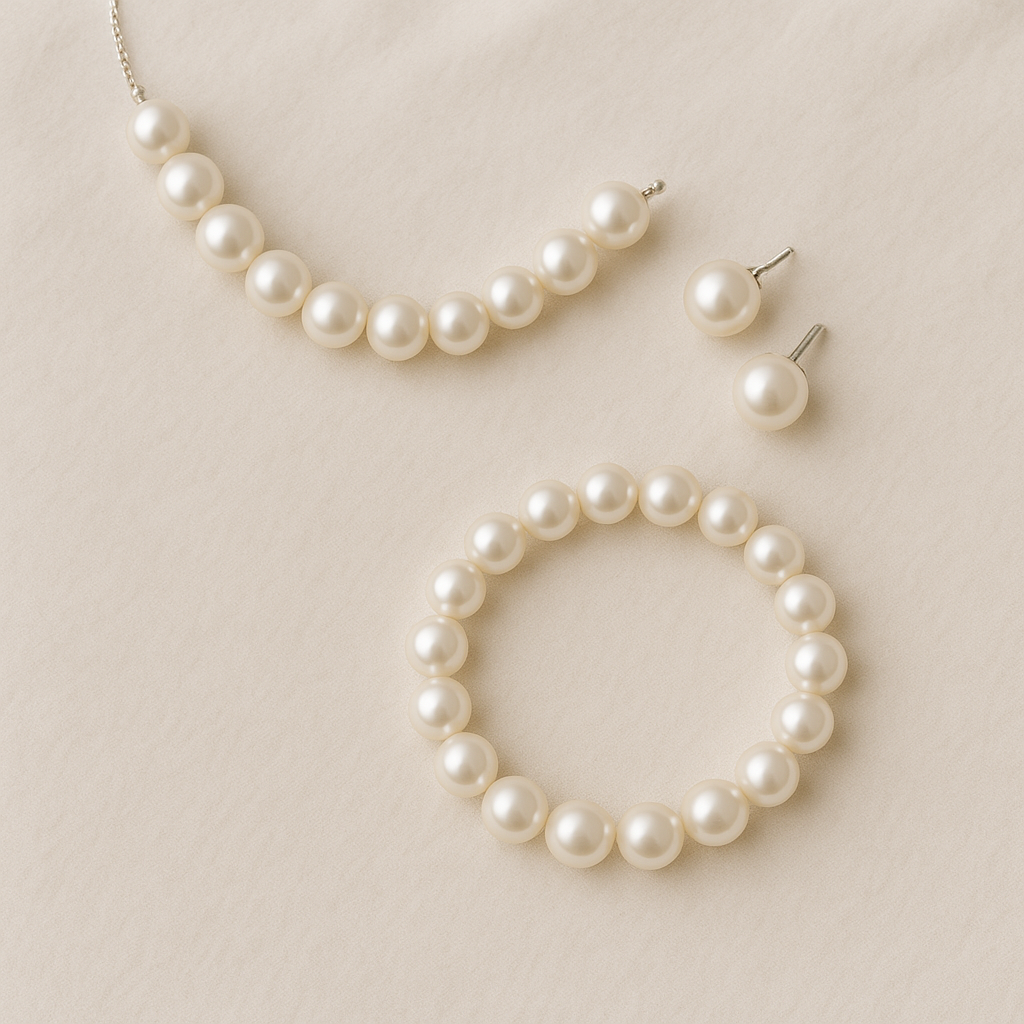Pearls are timeless, elegant, and versatile—making them a staple in any jewelry collection. Whether you’re new to pearls or looking to expand your knowledge, this guide will walk you through everything you need to know about pearl jewelry, from types and care tips to styling ideas and buying advice.
1. Types of Pearls
Not all pearls are created equal! Here’s a breakdown of the most popular types:
Natural vs. Cultured Pearls
- Natural Pearls: Formed without human intervention when an irritant (like sand) gets trapped inside an oyster. They’re extremely rare and valuable.
- Cultured Pearls: Created by inserting a small bead or piece of tissue into an oyster, stimulating pearl formation. Most pearls on the market today are cultured.
Freshwater Pearls
- Appearance: Often irregular in shape with softer luster; available in white, cream, pink, lavender, and more.
- Best For: Casual wear and affordable yet stylish jewelry options.
Akoya Pearls
- Appearance: Round, smooth, and highly lustrous; typically white or cream with overtones of pink, silver, or green.
- Best For: Classic, sophisticated pieces like necklaces and earrings.
Tahitian Pearls
- Appearance: Known for their dark colors, ranging from black to gray, with peacock, green, or purple overtones.
- Best For: Bold, statement-making jewelry.
South Sea Pearls
- Appearance: Large, luxurious, and creamy white, gold, or silver in color; prized for their size and shine.
- Best For: High-end, investment-worthy jewelry.
2. Factors That Determine Pearl Quality
When shopping for pearls, consider these key factors:
- Luster: The shine and reflection of light off the surface. Higher luster means better quality.
- Surface: Look for minimal blemishes or imperfections. Flawless pearls are rarer and more expensive.
- Shape: Round pearls are the most sought-after, but baroque (irregular) shapes have unique charm.
- Size: Larger pearls are generally more valuable, especially in South Sea and Tahitian varieties.
- Color: Choose based on personal preference, but remember that overtone (secondary hue) adds depth.
3. Popular Pearl Jewelry Pieces
Here’s how pearls are commonly used in jewelry:
Necklaces
- Classic Strand Necklace: A single strand of uniform pearls is a wardrobe essential.
- Graduated Necklace: Features pearls that increase in size toward the center, creating a dramatic effect.
- Baroque Necklace: Made with irregularly shaped pearls for a modern twist
Earrings
- Studs: Simple and elegant, perfect for everyday wear.
- Drop Earrings: Add movement and sophistication, ideal for formal events.
- Hoops: Combine pearls with metal for a contemporary look.
Bracelets
- Single Strand Bracelet: Matches well with pearl necklaces for a coordinated set.
- Multi-Strand Bracelet: Offers a layered, luxe appearance.
- Bangles: Incorporate pearls into mixed-metal designs for a modern vibe.
Rings
- Solitaire Pearl Ring: A single pearl set in gold or silver makes a subtle statement.
- Cluster Rings: Multiple small pearls create a vintage-inspired design.
Brooches & Pins
- Pearl brooches add elegance to blazers, scarves, or hats—a nod to classic fashion.
4. How to Style Pearl Jewelry
Pearls are incredibly versatile and can be styled for any occasion. Here are some tips:
Casual Looks
- Pair freshwater pearl studs or a delicate bracelet with jeans and a blouse for effortless chic.
- Layer pearl necklaces of varying lengths for a trendy, bohemian vibe.
Workwear
- Opt for a simple pearl necklace or drop earrings to elevate professional attire.
- A pearl watch or bracelet adds polish to business-casual outfits.
Evening Glamour
- Wear a classic Akoya pearl strand with a little black dress for timeless elegance.
- Choose statement Tahitian pearl earrings or a bold ring for a glamorous touch.
Modern Twists
- Mix pearls with leather cords, chains, or colorful beads for an edgy update.
- Experiment with asymmetrical designs, such as mismatched pearl earrings.
5. Caring for Your Pearl Jewelry
Pearls require special care to maintain their beauty and longevity:
- Storage: Keep pearls separate from other jewelry to avoid scratches. Store them in a soft pouch or lined box.
- Cleaning: Wipe pearls gently with a damp cloth after wearing to remove oils and dirt. Avoid harsh chemicals or ultrasonic cleaners.
- Wearing: Put on pearls last when getting ready—they should not come into contact with perfumes, lotions, or hairspray.
- Restringing: If you own a pearl necklace, restring it every few years to prevent breakage.
6. Buying Tips for Pearl Jewelry
- Set a Budget: Prices vary widely depending on type, quality, and size. Freshwater pearls are budget-friendly, while South Sea pearls are luxury investments.
- Buy from Reputable Sellers: Ensure authenticity by purchasing from trusted jewelers or certified dealers.
- Ask About Certification: High-quality pearls often come with grading reports detailing their characteristics.
- Consider the Setting: Gold and silver settings enhance pearls’ natural beauty, so choose one that complements your style.
7. Fun Facts About Pearls
- Birthstone: Pearls are the birthstone for June and symbolize purity, innocence, and new beginnings.
- History: Cleopatra famously dissolved a pearl in vinegar and drank it to prove her wealth!
- Sustainability: Cultured pearls are environmentally friendly compared to mining gemstones.
8. Trend Alert: Modern Takes on Pearls
Pearls aren’t just for grandmothers anymore! Designers are reinventing pearl jewelry with fresh, innovative styles:
- Mixed Materials: Combining pearls with metals, enamel, or resin creates bold, eclectic designs.
- Layering: Stacking pearl necklaces or bracelets adds dimension to minimalist outfits.
- Asymmetry: Irregularly shaped pearls and mismatched earrings are having a moment in fashion.
Final Thoughts
Pearls are more than just accessories—they’re heirlooms that tell stories of elegance and refinement. With proper care and thoughtful styling, pearl jewelry can become a cherished part of your collection for years to come.
What’s your favorite way to wear pearls? Let us know in the comments below—we’d love to hear your thoughts!


